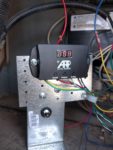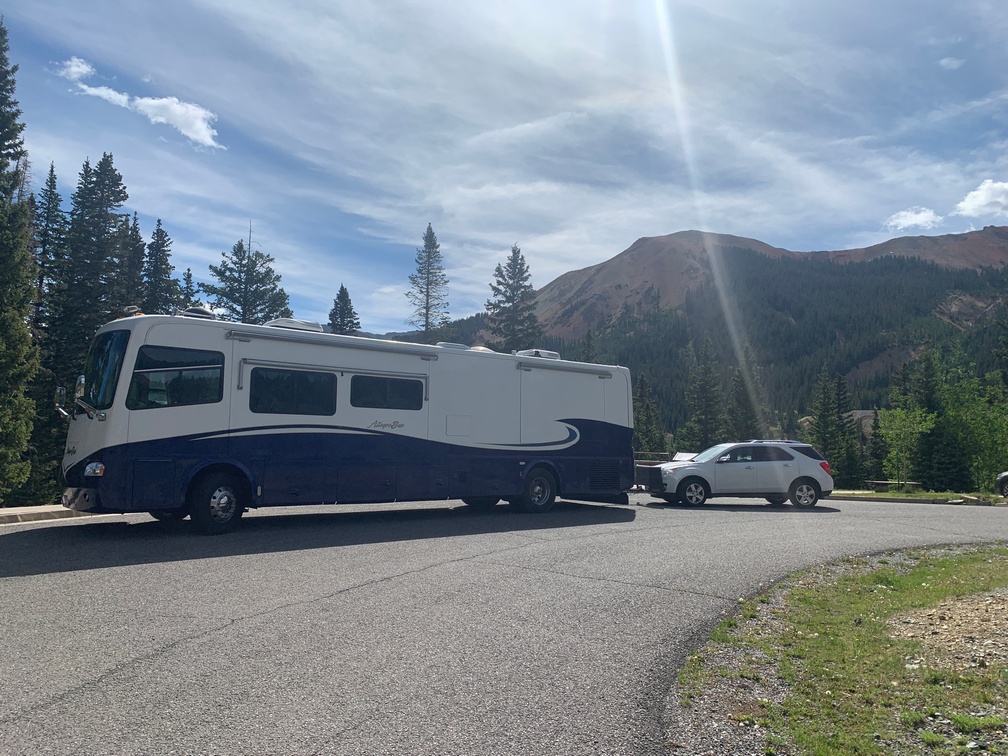 Last summer our fridge worked OK most of the time, but I saw a device that could make it work better for us and also take out a bit of anxiety that some folks experience with having that type of refrigerator.
Last summer our fridge worked OK most of the time, but I saw a device that could make it work better for us and also take out a bit of anxiety that some folks experience with having that type of refrigerator.
First thing, absorption refrigerators have no moving parts, no compressors or internal fans blowing the cold air around like the one in your house. They can run on 120v or 12v with propane. When the temp stays under 90 degrees outside, they work very well. Once the temp goes beyond that, it takes a bit of help to keep them cooling your food. Last summer while camping in AZ and UT during June (hot) I went out and bought an 8″ clip-on 120v fan to put behind the fridge to pull cooler air thru the outside vent openings to run it past the condenser coils and out the roof vent. That helped quite a bit. But something I didn’t know at the time was the Norcold automatically goes into a defrost cycle every 24 hours. It basically turns on heaters for two hours to keep the internal coils from freezing up like a block of ice. That was not helpful on 100 degree days when there wasn’t any chance of frost building up. In actuality, it is a bad design that should be able to sense the need for that defrost cycle and not run it on a set schedule.
 Late last summer I ran into a few good ole boys from Virginia while we were camping in Maine. One of them, the engineer of the trio, showed me a device called an ARP he had mounted on the back of his fridge. It did a few cool things. Its main purpose was to shut off the fridge if the boiler got hotter than its normal running temp. Norcold had put on a recall device that shut off the fridge at 800 degrees. This one does that at around 300 degrees, limiting the metal fatigue and preventing it from clogging up the system due to the solution getting way too hot, requiring whats called a burping or a much worse situation where it will no longer work at all, and lastly a catastrophic problem that could burn down the house. The ARP will also would turn the fridge back on once the normal temp was reached again. That’s something the recall device doesn’t do. To turn that device back on from the recall device you need a magnet to reset its internal switch.
Late last summer I ran into a few good ole boys from Virginia while we were camping in Maine. One of them, the engineer of the trio, showed me a device called an ARP he had mounted on the back of his fridge. It did a few cool things. Its main purpose was to shut off the fridge if the boiler got hotter than its normal running temp. Norcold had put on a recall device that shut off the fridge at 800 degrees. This one does that at around 300 degrees, limiting the metal fatigue and preventing it from clogging up the system due to the solution getting way too hot, requiring whats called a burping or a much worse situation where it will no longer work at all, and lastly a catastrophic problem that could burn down the house. The ARP will also would turn the fridge back on once the normal temp was reached again. That’s something the recall device doesn’t do. To turn that device back on from the recall device you need a magnet to reset its internal switch.
The second thing it has is a built-in controller to power up to two blower  fans you mount back where I had put that clip-on fan last summer. A sensor clipped to the condenser coil monitors the coil temp and tells it when to turn the fan(s) on or off.
fans you mount back where I had put that clip-on fan last summer. A sensor clipped to the condenser coil monitors the coil temp and tells it when to turn the fan(s) on or off.
But the best part I think it does is disable the defrost mode on the fridge. That is a settable option on the device. The fan temp can be set to a temp you desire it to turn on, and there are many other settings that I won’t fool with.
 I installed ours the week prior to leaving for the NW trip. I didn’t like their suggestion for mounting the unit, so I made a bracket from some Simpson building brackets for the controller and one fan . You should be able to tell what I did by the pictures here. I think I will buy a can of black spray paint when we get back home.
I installed ours the week prior to leaving for the NW trip. I didn’t like their suggestion for mounting the unit, so I made a bracket from some Simpson building brackets for the controller and one fan . You should be able to tell what I did by the pictures here. I think I will buy a can of black spray paint when we get back home.
I also modified the inside of that space to make the air from  my blower fan flow a bit more smoothly toward the coils with a bit of sheet aluminum. There was a 2×4 just above the bottom vent opening, so making a 45 degree baffle to direct the flow directly to the coils made sense. I have heard there is a similar situation above the refrigerator, and when I get home, I will look into making something to divert the hot air smoothly over to the vent.
my blower fan flow a bit more smoothly toward the coils with a bit of sheet aluminum. There was a 2×4 just above the bottom vent opening, so making a 45 degree baffle to direct the flow directly to the coils made sense. I have heard there is a similar situation above the refrigerator, and when I get home, I will look into making something to divert the hot air smoothly over to the vent.
It seems to be working as planned. I was able to see the blower fan turn on at 130 degrees for the coils; and in the 95 degree weather, the ice cream stayed hard as the freezer temp never got above 12 degrees and the fridge stayed at 39 or below!
The real test will probably be next month when we get east of the cascades heading toward Glacier National Park.
Another simple mod I did was to replace the incandescent fridge festoon type bulb with a 6000 kelvin LED from M4 products. I’m sure the heat difference will be negligible since it’s not on much, but it’s so much brighter than that original bulb, its literally like night and day.
